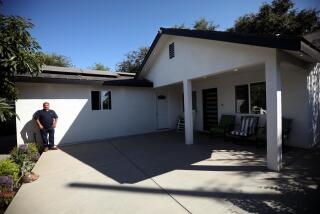West’s Population Boom Means Farewell to Wide Open Spaces
- Share via
EDWARDS, Colo. — Some townhouses in this mountain community are so close together, one could reach across the backyard fence and use a neighbor’s barbecue grill with a bit of effort.
Bumper-to-bumper traffic at the lone traffic light frustrates old-timers and newcomers alike. And finding a parking spot near a favorite restaurant can be as challenging as finding one in Denver, 115 miles away.
Getting away from it all is getting tougher in the West. Not only are populations booming, but people who move to once-remote mountain towns want to bring along city conveniences--easy access to major highways, abundant shopping, restaurants and theaters.
They bring their city problems with them when they move to towns like Edwards, in the brush-covered Eagle River Valley 15 miles west of Vail.
“Most people come up looking for a place on a creek, with a meadow and some trees,” said Fritz Schmidt, a longtime resident. “If there is someplace like that, it’s usually in a subdivision.”
Secluded spots an hour’s drive from the nearest grocery store can still be found in areas without water or other services, but no one wants to live there, said John Lovett, an investor who moved to Edwards in 1998.
“There is lots of sagebrush land out in Wyoming, Montana, and you can buy it cheap. But when you consider the places that have what you need, there are not that many places to live,” he said.
“Americans have gotten used to comfort, and they have been spoiled,” said Patricia Limerick of the Center of the American West, a think tank based at the University of Colorado in Boulder. “Seclusion is for the rarest and oddest type of people who see independence as not having a faucet or a sewer tap.”
Edwards, which offers easy access to White River National Forest recreation areas, is among a string of communities along the booming Interstate 70 corridor in the mountains west of Denver.
Eagle County was the 10th fastest-growing county in the nation in 2000, expanding 90% to 41,659 residents from 21,928 in 1990.
In 1985, Edwards was an agricultural community of about 1,400 people with two mobile home parks, a post office and a cafe. It originally was envisioned as a place where workers from nearby ski resorts could find affordable housing.
Today, it has more than a dozen restaurants, two shopping centers and five subdivisions, including two gated communities that provide housing to about 8,500 people.
Townhouses cost between $200,000 and $400,000. In Cordillera, one of the gated communities, homes average $1.6 million, said Ken Marchetti, administrator for the Edwards Metropolitan District, a quasi-governmental body that provides services to the unincorporated community.
Some of its growth is fueled by nearby Vail and Beaver Creek ski resorts, but Eagle County planners say most comes from retired business owners and executives from California and Texas. Other transplants are from Boulder and Aspen, which have become increasingly crowded themselves.
“It’s a beautiful area with great recreational amenities,” Marchetti said. “There’s skiing, snowshoeing, snowmobiling in the winter. There are at least 10 golf courses in the area, and there’s hiking, mountain biking and all kinds of outdoors activities in the summer. That’s the main draw.”
Nearly a third of all homes are second homes, according to the Eagle County Planning Department.
A few blocks from Edwards’ business center, Bruce Eaton has lived in a yellow farmhouse for 40 years. It seems out of place among the wood-frame, blue, red and earth-tone lapped-siding condominiums and single-family homes in neighboring subdivisions.
“There are more people. More traffic. More crime. This just happens to be where it’s at,” said Eaton, who owns a gravel pit and raises about 80 head of cattle.
Growth isn’t all bad, he says.
“I kind of like it. You don’t have to drive as far to get groceries or eat at a restaurant. I never did like isolation.”
Lovett, who lived in Boulder for years but left when it became too big, moved to Edwards for its amenities and small-town feeling.
“We’re still in a one-stoplight town,” Lovett said.
More to Read
Sign up for Essential California
The most important California stories and recommendations in your inbox every morning.
You may occasionally receive promotional content from the Los Angeles Times.













